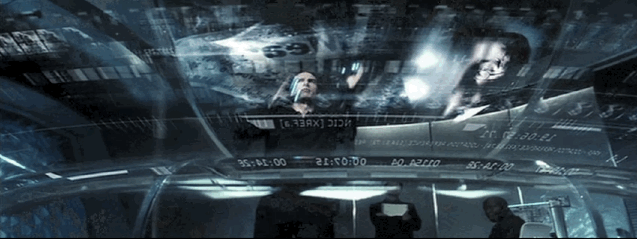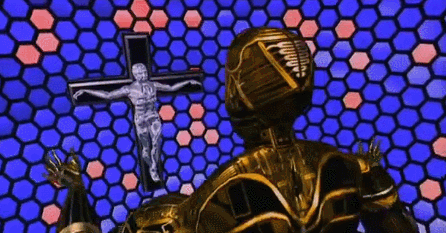
John Underkoffler has the kind of name screenwriters bestow on renegade geniuses in superhero movies. It’s lucky then that in our entirely disappointing universe, he lives up to the inherent coolness of that monicker.
One of the brains behind the look and technological philosophy expressed in the original ‘Iron Man’ movie and ‘Minority Report,’ his thoughts on the dystopian and utopian potential of all kinds of real world technology are fascinating.
I spoke to Underkoffler at length and it really was not enough time. Here are the highlights:
Technology is political
…because of the way people form technology companies, technology itself ends up expressing a world view. Technology is political. Most people claim it isn’t or that it is fundamentally utopian. Commercial technology always expresses a world view. You just need to spend 90 seconds following the money.

Tony Stark = libertarian
Stark’s character arc is optimistic but his take and approach to technology is utterly libertarian. I’m neither an optimist nor a pessimist. I start from the premise that technology is neutral but inflected by what we think about it and what we try to do with it.
User interface (UI) is the sun at the heart of the technology universe


The centre of the tech universe is UI. There’s practically no dialogue about the humanistic and technological meaning of UI and how to interpret that. That’s to the advantage of people who push technology as a push button convenience, like Uber for instance.
I want to produce technology that is ennobling and enabling. Technology that makes individuals more power in both a synthetic and creative sense.
Killing the keyboard and mouse won’t kill a lot of other problems
Shifting from fingers on a keyboard and mouse to touchscreens and ultimately heads-up displays has no bearing on whether a user is given something reductive or a powerful exoskeleton.
It’s about how construe and build technology. JARVIS in ‘Iron Man’ is a servant. Having Paul Bettany voice him was a very smart choice.
I believe you can build artificial intelligence (AI) that is directly empowering at an individual level. That’s what Oblong’s technology and products are about. Radically empowering individual team members is an otherwise conservative business culture improves everything.
The two sins of UI design
I hate the idea that UI is arbitrary and can be slapped on in an amusing or attractive way. Sin number two is that there has been essentially no advance in the state of UI in the last 30 years.
We’re still using the Macintosh UI. The machines are more powerful but we are not. We’re still communicating in the same way.
Typewriters to tablets – how we use technology changes how we write
Every slight variation in the means of production of tech leads to different tone and different style. I used to use a typewriter and what came out was totally different to what came out with a word processor. I bet that you don’t ever type your stories on a smartphone or a tablet.
That’s a critically important point. Even small differences in UI modality make a huge difference in cognitive engagement. If you’re going to talk about UI, you have to acknowledge simple truths.
Virtual reality (VR) needs great UI and no one is building it

First off, everyone forgets it’s not our first time at the rodeo with VR. People built it 35 years ago. What no one is working on is the UI. Everyone is building these headsets but unless we have some way of interacting, it’ll be 360 degree cinema.
Augmented reality (AR) is more obviously useful. VR is putting a bucket on your head and eliminating the useful pieces of reality. You then have to reinvent reality and the social cues for relating to other people. The legal implications are hilarious and staggering. VCs should invest in VR legal funds for the lawsuits that will come up.
Twitter and Facebook lie through their UI
The experience on Facebook and Twitter is directly duplicitous. Even the tired graphical user interface (GUI) on the desktop makes an effort to represent the underlying computational space in a way that the operator of the machine has a mental model of what’s going on.
When you type something on Facebook, you don’t know who is going to see it – not really. The basic function of that system is obscured to you.
William Gibson’s ‘Neuromancer’ and Neal Stephenson’s ‘Snow Crash’ are the typical models for VR worlds – I like those worlds with agency. Snow Crash’s Metaverse is representational. Cyberspace is non-representational, it’s abstract, geometric. Twitter and Facebook deny you agency.
Great science fiction is less interested in technical details than consequences
Really good science fiction doesn’t spend time on the wonder of things like an artificial consciousness. Instead those narratives drive straight into the consequences of a world where people take that for granted.
In ‘Neuromancer’ Case speaks to [the AI] Dixie Flatline and he’s sad. [Another AI] Wintermute is lonely. All the stuff that happens in the book are just a bunch of side effects in a giant AI dating attempt.
Kids of the future could reject technology
A backlash would have to be cultural. The technology itself would have to become culture. There have been the Shakers, the Luddites, the Amish, but it’s always be small sects. They become cultural footnotes.

Technology doesn’t have to be designed from male anger
I would like it to be possible to have large scale commercial success that isn’t predicated on male aggression and entrapping UIs. I think you can have massive commercial success and that your customers might derive a commercial advantage, because they are creating, synthesising and generative.
Dark patterns of design are everywhere
People are building UIs where the UI becomes a mechanism of control – making it hard to find the unsubscribe button or how your information is sold. You distort the UI and you’ve inserted a mechanism for financial and political.
No tech giant is forever
Look how quickly companies come and go. Look how HTC came and went. Apple’s on the top but it may be on a decline. Hubris is only as big as the balloons that support it.
As long as there’s a few of us working on a different approach, things aren’t so lonely that you want to fill your pockets with stones and walk out into the surf. Ironically, it’s the free market that will allow the punk idea of this to take hold.
All it takes is a couple of big companies to promote visionaries within them and have them empower their teams and give them more radically capable and powerful tools.
The myth of the genius founder is just that… a myth
The mythology of brilliant founders forces the narrative to be built on the idea of a solitary enterprise. Invention is always more like a tea bag in a giant pot, with the influence percolating through many people.

The better Steve? Wozniak over Jobs
I learned an enormous amount from the Apple II Plus. That thing was a gift. You could pry the top off and there were all the chips. The original reference manual had a fold-out schematic of the whole system.
Douglas Englebart is the god of UI designers
Yes, I said individuals don’t tend to invent alone but Englebart almost singlehandedly disseminated a universe of UI ideas. We’re still only using about 10 percent of what he showed. Those are exhilarating moments. The experience of making and using technology and UI should be exhilarating. You should have agency.
Ultimately, the future is positive
In the past five years, the explosion of availability of resources about programming has been one of the big keys, one of the escape hatches. So long as there are people who make new things, there are people who can get us out of a bind. The more people are programming, there more agency in the world.
Underkoffler puts all of this thinking into action through his company, Oblong, which has built Mezzanine, a visual collaboration platform that links teams in different locations in a pretty exciting way.
I’ll have a follow up piece on how that works and whether it can actually change the way we work together.
Get the TNW newsletter
Get the most important tech news in your inbox each week.




